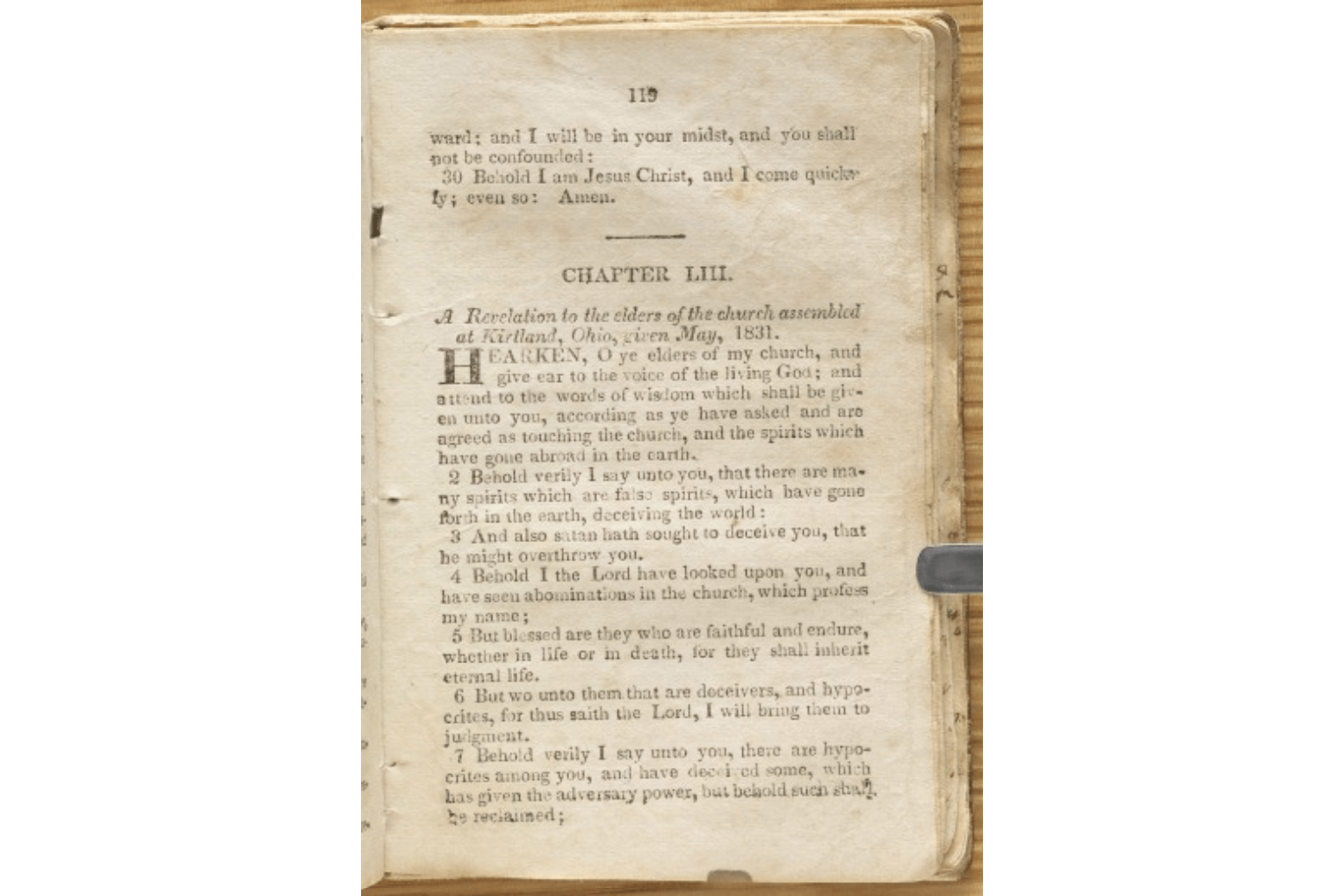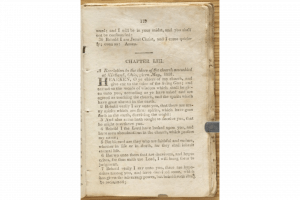Historical Context and Background of D&C 50
Brief Synopsis by Steven C. Harper
What happens when young missionaries convert well over a hundred people in a short time, and then the missionaries and the most mature spiritual leaders among the converts leave town? According to John Whitmer, “The enemy of all righteous [gets] hold of some of those who profesed to be his followers, because they had not sufficent knowledge to detect him in all his devices.”1 According to a local newspaper in northeastern Ohio,
Immediately after Mr. R[igdon] and the four pretended prophets left Kirtland, a scene of the wildest enthusiasm was exhibited, chiefly, however, among the young people; they would fall, as without strength, roll upon the floor, and, so mad were they that even the females were seen in a cold winter day, lying under the bare canopy of heaven, with no couch or pillow but the fleecy snow.2
When one of the missionaries, Parley Pratt, returned from Missouri, he noticed that
some very strange spiritual operations were manifested, which were disgusting, rather than edifying. Some persons would seem to swoon away, and make unseemly gestures, and be drawn or disfigured in their countenances. Others would fall into ecstacies, and be drawn into contortions, cramp, fits, etc. Others would seem to have visions and revelations, which were not edifying, and which were not congenial to the doctrine and spirit of the gospel. In short, a false and lying spirit seemed to be creeping into the Church.”3
John Whitmer reported that after Joseph arrived on the scene “these things grieved the servants of the Lord.” They counseled together at Joseph’s home. They did not know what to do, so Joseph sought and received section 50 “in consequence of their not being perfectly acquainted with the different operations of the Spirits which are abroad in the earth.”4
In section 50 Christ condescends to the elders’ intellectual level in order to be understood. He reaches them where they are and enlightens them. This kind of teaching has results beyond mastery of facts. As a result of it, the weak become strong, the deceived become discerning. Though Satan had power over the deceived elders, those who “attend to the words” of this revelation are promised power over him. “The spirits shall be subject unto you,” Christ assured them on the condition that they act out his instructions precisely. Does it work?
Before the revelation Jared Carter had been confused by and powerless to act in the face of the strange things he witnessed. After the revelation he was neither confused nor powerless. He was conducting a sacrament meeting in Amherst, Ohio with his companion when a young woman fell to the floor. Jared, doubting that the Holy Spirit would interrupt the sacrament, thought a false spirit was at work. He suggested to his companion that they “try that Spirit according to the revelation that God had given.” He explained how they followed verses 31–34 precisely: “We kneeled down and asked our Heavenly Father in the name of Christ, that if that spirit which the sister possessed was of him, he would give it to us. We prayed in faith, but we did not receive the Spirit.”
Jared’s companion made a weak statement “which was not proclaiming against the spirit,” as verse 32 commands. “I arose and proclaimed against it with a loud voice,” Jared wrote, reflecting his intimate knowledge of the revelation. Most of the congregation objected, sure that the young woman was full of the Holy Ghost like the queen in Alma 19. But this was a counterfeit, Jared discerned by the Holy Ghost, and rebuked by the power of the priesthood. He lost much of his influence among that group of Saints but, as he wrote, “I received assurance that I had the approbation of my Heavenly Father, which was better than the good will of many deceived brethren.”5
Section 50 puzzles some modern students, who sometimes jump too hastily to the conclusion that anyone who sees a vision or falls to the floor unconscious or speaks in an unknown tongue is clearly not experiencing the Holy Ghost. If those were the criteria for discerning, we would have to reject large parts of the Book of Mormon and several sections of the Doctrine and Covenants along with much of our history. It is not that simple. Satan is abroad deceiving. As Section 50 says, a knee-jerk reaction against false spirits can actually lead a person to be “seized” with a false spirit themselves. Ironically, a smug certainty that one would not be fool enough to fall for the kinds of things some early converts did may be an indication that one has already been deceived. Joseph taught, “It is that smooth, sophisticated influence of the Devil, by which he deceives the whole world.”6
Discerning spirits takes a sound mind, but it is a spiritual, not primarily an intellectual, process. To gain power over false spirits, one must obey the voice of Jesus Christ, have him cleanse and purify them, and learn the difference between light and darkness. For Joseph Smith, Jared Carter and many others, that lesson has been learned by experiencing both and learning to recognize the difference.
Like Jared Carter, several elders acted out the revelation and got the Church back in order. Parley Pratt told how he obeyed the Lord’s command in verse 37: “Joseph Wakefield and myself visited several branches of the Church, rebuking the wrong spirits which had crept in among them, setting in order things that were wanting.”7
1. “John Whitmer, History, 1831–circa 1847,” p. 10, The Joseph Smith Papers, accessed July 30, 2020.
2. [Matthew S. Clapp], “Mormonism,” Painesville (OH) Telegraph, February 15, 1831, [1]–[2], italics in original.
3. Parley P. Pratt, The Autobiography of Parley Parker Pratt, Edited by Parley P. Pratt Jr. New York: Russell Brothers, 1874), 65.
4. “Revelation, 9 May 1831 [D&C 50],” p. 82, The Joseph Smith Papers, accessed July 30, 2020.
5. Autobiography of Jared Carter, Church History Library, Salt Lake City.
6. Joseph Smith, Journal, 2 January 1843, Church History Library, Salt Lake City.
7. The Autobiography of Parley P. Pratt, revised and enhanced edition, edited by Scot Facer Proctor and Maurine Jensen Proctor (Salt Lake City: Deseret, 2000), 79.
Additional Context by Casey Paul Griffiths
From Doctrine and Covenants Minute
From the time Joseph Smith arrived in Ohio, a major cause for concern among the converts in Kirtland was their overabundance of religious enthusiasm. John Whitmer, the first Church leader from the East to arrive in Ohio, noted with some distress that “the enemy of all righteous had got hold of some of those who professed to be his followers, because they had not sufficient knowledge to detect him in all his devices.” Describing the unusual manifestations among the converts in more detail, Whitmer recorded that “some had visions and could not tell what they saw, some would fancy to themselves that they had the sword of Laban, and would wield it as expert as a light dragoon, some would act like an Indian in the act of scalping, some would slide or scoot [on] the floor, with the rapidity of a serpent, which the[y] termed sailing in the boat to the Lamanites, preaching the gospel. And many other vain and foolish maneuvers that are unseeming, and unprofitable to mention. Thus the devil blinded the eyes of some good and honest disciples” (Whitmer, History, 10, 26–27, JSP).
Parley P. Pratt, returning from his mission to the Lamanites, also noted disturbing manifestations among the individuals whom he had helped convert just a few months earlier. “As I went forth among the different branches, some very strange spiritual operations were manifested, which were disgusting, rather than edifying,” he later wrote. “Some persons would seem to swoon away, and make unseemly gestures, and be drawn or disfigured in their countenances. Others would fall into ecstasies, and be drawn into contortions, cramp, fits, etc. Others would seem to have visions and revelations, which were not edifying, and which were not congenial to the doctrine and spirit of the gospel. In short, a false and lying spirit seemed to be creeping into the Church” (Pratt, Autobiography, 65).
Even people not affiliated with the Church began to notice these unsettling displays among the converts. A reporter from the nearby newspaper, the Painesville Telegraph, wrote, “A scene of the wildest enthusiasm was exhibited, chiefly, however, among the young people; they would fall, as without strength, roll upon the floor, and, so mad were they that even the females were seen in a cold winter day, lying under the bare canopy of heaven, with no couch or pillow but the fleecy snow.” The Telegraph article also noted, “At other times they are taken with a fit of jabbering that which they neither understand themselves nor any body else, and this they call speaking foreign languages by divine inspiration. Again, the young men are seen running over the hills in pursuit, they say, of balls of fire which they see flying through the air” (“Mormonism,” Painesville Telegraph, 15 Feb. 1831, 1–2).
Some of these manifestations became physically dangerous. An early African American convert to the Church, known only in the record as “Black Pete,” was almost seriously injured during one such incident. According the Apostle George A. Smith (who was later the Church historian), “Black Pete got sight of one of those revelations carried by a black angel. . . . He started after it, and ran off a steep wash bank twenty-five feet high, passed through a tree top into the Chagrin river beneath. He came out with a few scratches, and his ardor somewhat cooled” (Journal of Discourses, 11:4). A newspaper from the time also noted the incident, though it mixed up some of the details: “The Mormonites have among them an African (or, as [abolitionist William Lloyd] Garrison would say, an Africo American,) who fancies he can fly. . . . He accordingly chose the elevated bank of Lake Erie as a starting place, and, spreading his pinions, he lit on a tree-top, some fifty [feet] below, sustaining no other damage than the demolition of his faith in wings without feathers” (“Mormonites,” The Sun (Philadelphia), 18 August 1831).
Concerned over these manifestations, Church leaders asked Joseph Smith for a revelation to clarify the matter. John Whitmer later recorded, “These things grieved the servants of the Lord, and some conversed together on this subject, and others came in and we were at Joseph Smith Jr. the seers, and made it a matter of consultation, for many would not turn from their folly, unless God would give a revelation, therefore the Lord spake to Joseph” (Whitmer, History, 26–27, JSP).
This revelation, now known as Doctrine and Covenants 50, was received in the presence of several people. Parley P. Pratt noted the way the revelation came to Joseph Smith: “Feeling our weakness and inexperience, and lest we should err in judgment concerning these spiritual phenomena, myself, John Murdock, and several other Elders, went to Joseph Smith and asked him to inquire of the Lord concerning these spirits or manifestations. After we had joined in prayer in his translating room, he dictated in our presence the following revelation [section 50].” Parley also recorded the manner in which Joseph dictated the revelation, writing, “Each sentence was uttered slowly and very distinctly, and with a pause between each, sufficiently long for it to be recorded, by an ordinary writer, in long hand. This was the manner in which all his written revelations were dictated and written. There was never any hesitation, reviewing, or reading back, in order to keep the run of the subject; neither did any of these communications undergo revisions, interlinings, or corrections. As he dictated them so they stood, so far as I have witnessed; and I was present to witness the dictation of several communications of several pages each” (Pratt, Autobiography, 65–66).


